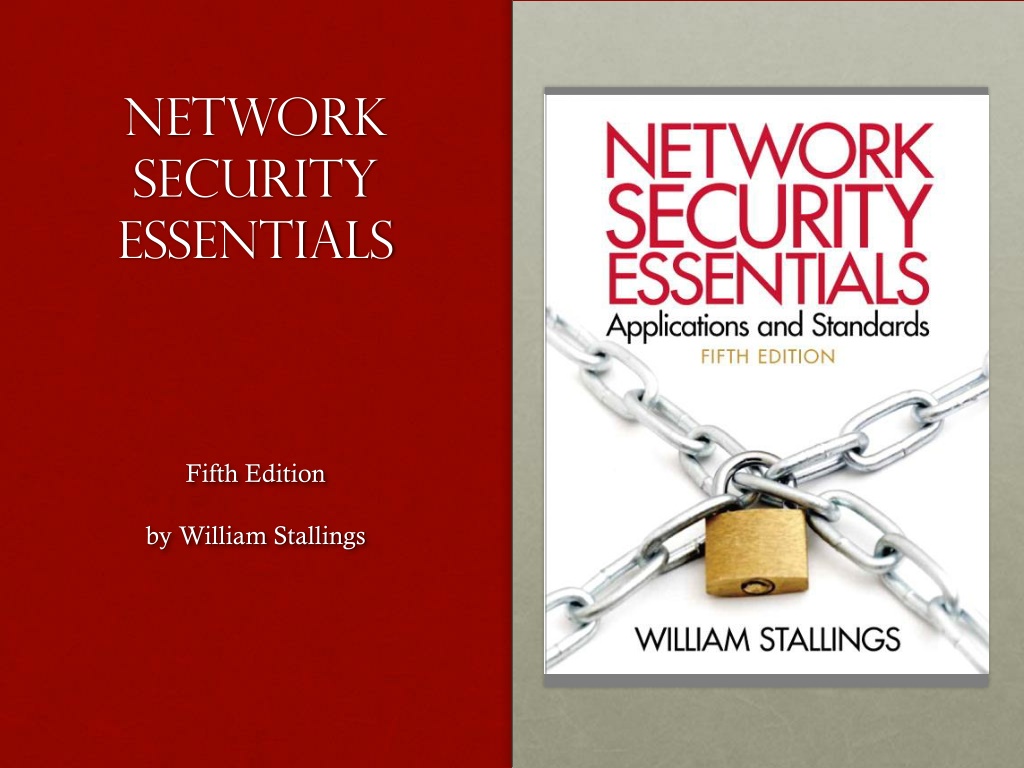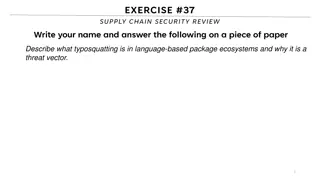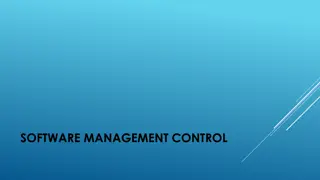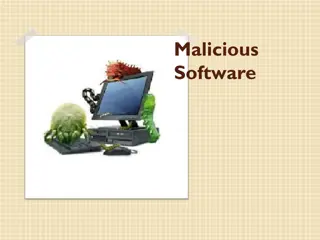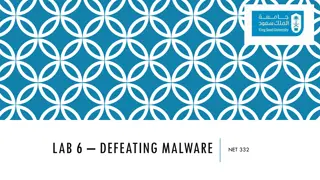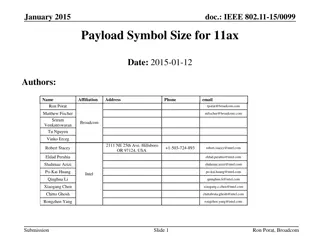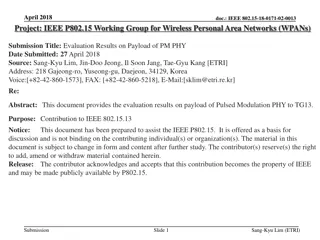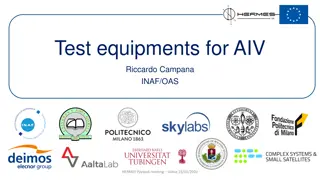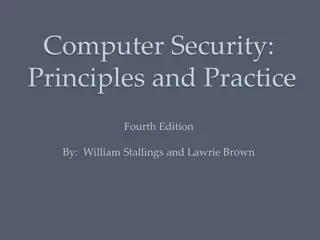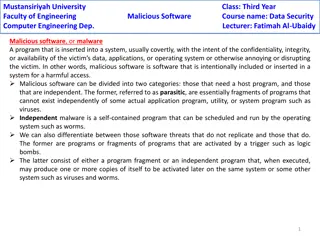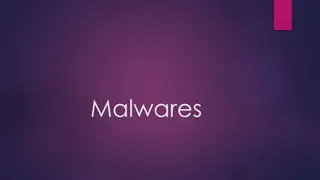Understanding Malicious Software: Classification and Payload Actions
Malicious software, or malware, can be broadly classified based on how it spreads and the actions it performs once on a target system. This classification includes distinctions between viruses, worms, trojans, botnets, and blended attacks. The payload actions of malware can range from file corruption to data theft using methods like keylogging or spyware programs. Attack kits have evolved over time, making malware creation more accessible to a wider range of individuals.
Download Presentation

Please find below an Image/Link to download the presentation.
The content on the website is provided AS IS for your information and personal use only. It may not be sold, licensed, or shared on other websites without obtaining consent from the author. Download presentation by click this link. If you encounter any issues during the download, it is possible that the publisher has removed the file from their server.
E N D
Presentation Transcript
Network Security Essentials Fifth Edition by William Stallings
Chapter 10 Malicious Software
Table 10.1 Terminology for Malicious Software (This table can be found on page 301 in the textbook.)
A Broad classification of malware Can be classified into two broad categories: Based first on how it spreads or propagates to reach the desired targets Then on the actions or payloads it performs once a target is reached Propagation mechanisms: Include infection of existing executable or interpreted content by viruses that is subsequently spread to other system Exploit of software vulnerabilities either locally or over a network by worms or drive-by-downloads to allow the malware to replicate Social engineering attacks that convince users to bypass security mechanisms to install trojans or to respond to phishing attacks
Broad classification (continued) Earlier approaches to malware classification distinguished between: Those that need a host program, being parasitic code such as viruses Those that are independent, self-contained programs run on the system such as worms, trojans, and bots Another distinction used was: Malware that does not replicate, such as trojans and spam e-mail Malware that does, including viruses and worms Payload actions performed by malware once it reaches a target system can include: Corruption of system or data files Theft of service in order to make the system a zombie agent of attack as part of a botnet Theft of information from the system, especially of logins, passwords, or other personal details by keylogging or spyware programs Stealthing where the malware hides its presence on the system from attempts to detect and block it Blended attack Uses multiple methods of infection or propagation to maximize the speed of contagion and the severity of the attack
Attack kits Initially the development and deployment of malware required considerable technical skill by software authors This changed with the development of virus-creation toolkits in the early 1990s and more general attack kits in the 2000s These toolkits are often known as crimeware Include a variety of propagation mechanisms and payload modules that even novices can combine, select, and deploy Can easily be customized with the latest discovered vulnerabilities in order to exploit the window of opportunity between the publication of a weakness and the deployment of patches to close it These kits greatly enlarged the population of attackers able to deploy malware
Attack sources Another significant malware development over the last couple of decades is the change from attackers being individuals to more organized and dangerous attack sources These include politically motivated attackers, criminals, organized crime, organizations that sell their services to companies and nations, and national government agencies This has significantly changed the resources available and motivation behind the rise of malware leading to development of a large underground economy involving the sale of attack kits, access to compromised hosts, and to stolen information
Viruses Parasitic software fragments that attach themselves to some existing executable content Can infect other programs or any type of executable content and modify them The modification includes injecting the original code with a routine to make copies of the virus code, which can then go on to infect other content One reason viruses dominated the malware scene in earlier years was the lack of user authentication and access controls on personal computer systems
Virus Structure A computer virus and many contemporary types of malware includes one or more variants of each of these components: Infection mechanism The means by which a virus spreads or propagates, enabling it to replicate Also referred to as the infection vector Trigger The event or condition that determines when the payload is activated or delivered Sometimes known as a logic bomb Payload May involve damage or benign but noticeable activity What the virus does, besides spreading
Virus phases During its lifetime, a typical virus goes through the following four phases: Dormant phase The virus is idle Will eventually be activated by some event Not all viruses have this stage Propagation phase The virus places a copy of itself onto other programs or into certain system areas on the disk Triggering phase The virus is activated to perform the function for which it was intended Can be caused by a variety of system events Execution phase The function is performed
Virus Classification by target Includes the following categories: Boot sector infector File infector Macro virus Multipartit e virus Infects a master boot record or boot record and spreads when a system is booted from the disk containing the virus Infects files with macro or scripting code that is interpreted by an application Infects files in multiple ways Infects files that the operating system or shell consider to be executable
Virus classification by concealment strategy Includes the following categories: Encrypted virus Portion of the virus creates a random encryption key and encrypts the remainder of the virus When an infected program is invoked, the virus uses the stored random key to decrypt the virus When the virus replicates, a different random key is selected Because the bulk of the virus is encrypted with a different key for each instance, there is no constant bit pattern to observe Stealth virus A form of virus explicitly designed to hide itself from detection by antivirus software The entire virus, not just a payload is hidden Polymorphic virus A virus that mutates with every infection, making detection by the signature of the virus impossible Metamorphic virus Mutates with every infection Rewrites itself completely at each iteration, increasing the difficulty of detection May change their behavior as well as their appearance
Macro and scripting viruses Macro viruses infect scripting code used to support active content in a variety of user document types Threatening for a number of reasons: A macro virus is platform independent Macro viruses infect documents, not executable portions of code Macro viruses are easily spread, as the documents they exploit are shared in normal use Because macro viruses infect user documents rather than system programs, traditional file system access controls are of limited use in preventing their spread
worms A program that actively seeks out more machines to infect Upon activation, the worm may replicate and propagate again To replicate itself, a worm uses some means to access remote systems: Electronic mail or instant messenger facility File sharing Remote execution capability Remote file access or transfer capability Remote login capability
Worm phases A worm typically uses the same phases as a computer virus: Dormant Propagation Triggering Execution The propagation phase generally performs the following functions: Search for appropriate access mechanisms to other systems to infect by examining host tables, address books, buddy lists, trusted peers, and other similar repositories of remote system access details Use the access mechanisms found to transfer a copy of itself to the remote system and cause the copy to be run
Target discovery Scanning/fingerprinting The function in the propagation phase for a network worm to search for other systems to infect Worm network scanning strategies: Random Each compromised host probes random addresses in the IP address space, using a different seed Produces a high volume of Internet traffic, which may cause generalized disruption even before the actual attack is lunched Hit list The attacker first compiles a long list of potential vulnerable machines Once the list is compiled, the attacker begins infecting machines on the list Each infected machine is provided with a portion of the list to scan This results in a very short scanning period, which may make it difficult to detect that infection is taking place Topological Uses information contained on an infected victim machine to find more hosts to scan Local subnet If a host is infected behind a firewall, that host then looks for targets in its own local network The host uses the subnet address structure to find other hosts that would otherwise be protected by the firewall
Mobile code Refers to programs that can be shipped unchanged to a heterogeneous collection of platforms and execute with identical semantics Transmitted from a remote system to a local system and then executed on the local system without the user s explicit instruction Often acts as a mechanism for a virus, worm, or Trojan horse to be transmitted to the user s workstation Popular vehicles for mobile code include: Java applets ActiveX JavaScript VBScript The most common ways of using mobile code for malicious operations on local system are: Cross-site scripting Interactive and dynamic Web sites E-mail attachments Downloads from untrusted sites or of untrusted software
Drive-by-downloads Exploits browser vulnerabilities so that when the user views a Web page controlled by the attacker, it contains code that exploits the browser bug to download and install malware on the system without the user s knowledge or consent Does not actively propagate as a worm does, but rather waits for unsuspecting users to visit the malicious Web page in order to spread to their systems
spam Unsolicited bulk e-mail Imposes significant costs on both the network infrastructure needed to relay this traffic and on users who need to filter their legitimate e-mails Most recent spam is sent by botnets using compromised user systems Is a significant carrier of malware May be used in a phishing attack Although a significant security concern, in many cases it requires the user s active choice to view the e-mail and any attached document or to permit the installation of some program, in order for the compromise to occur
Trojan horses Is a useful, or apparently useful, program or utility containing hidden code that, when invoked, performs some unwanted or harmful function Can be used to accomplish functions indirectly that the attacker could not accomplish directly Fit into one of three models: Continuing to perform the function of the original program and additionally performing a separate malicious activity Continuing to perform the function of the original program but modifying the function to perform malicious activity or to disguise other malicious activity Performing a malicious function that completely replaces the function of the original program
Payload system corruption Once malware is active on the target system, the next concern is what actions it will take on this system Examples: Data destruction on the infected system when certain trigger conditions were met Display unwanted messages or content on the user s system when triggered Encrypt the user s data and demand payment in order to access the key needed to recover this information (ransomware) Inflict real-world damage on the system Attempt to rewrite the BIOS code used to initially boot the computer Target specific industrial control system software Logic bomb Code embedded in the malware that is set to explode when certain conditions are met
Payload attack agent Malware subverts the computational and network resources of the infected system for use by the attacker Bot (robot), zombie, drone Secretly takes over another Internet-attached computer and then uses that computer to launch or manage attacks that are difficult to trace to the bot s creator A botnet is a collection of bots often capable of acting in a coordinated manner
Uses of bots Distributed denial-of-service (DDoS) attacks Spamming Sniffing traffic Keylogging Spreading new malware Installing advertisement add-ons and browser helper objects (BHOs) Attacking Internet Relay Chat (IRC) networks Manipulating online polls/games
Remote control facility Distinguishes a bot from a worm A worm propagates itself and activates itself, whereas a bot is controlled from some central facility Typical means of implementing is on an IRC server More recent botnets use covert communication channels via protocols such as HTTP Distributed control mechanisms, using peer-to-peer protocols, are also used, to avoid a single point of failure Once a communications path is established between a control module and the bots, the control module can activate the bots Can also issue update commands that instruct the bots to download a file from some Internet location and execute it
Payload information theft Keylogger Captures keystrokes on the infected machine to allow an attacker to monitor user login and password credentials Spyware Developed in response to efforts to try and stop keylogging Subvert the compromised machine to allow monitoring of a wide range of activity on the system which can result in significantly compromising the user s personal information Phishing Exploits social engineering to leverage the user s trust by masquerading as communication from a trusted source Spear-phishing An e-mail claiming to be from a trusted source, however, the recipients are carefully researched by the attacker, and each e-mail is carefully crafted to suit its recipient specifically
Payload stealthing Backdoor Also know as a trapdoor Is a secret entry point into a program that allows someone who is aware of the backdoor to gain access without going through the usual security access procedures Code that recognizes some special sequence of input or is triggered by being run from a certain user ID or by an unlikely sequence of events Usually implemented as a network service listening on some nonstandard port that the attacker can connect to and issue commands through to be run on the compromised system
Payload stealthing Rootkit A set of programs installed on a system to maintain covert access to that system with administrator (or root) privileges, while hiding evidence of its presence to the greatest extent possible Alters the host s standard functionality in a malicious and stealthy way An attacker has complete control of the system and can add or change programs and files, monitor processes, send and receive network traffic, and get backdoor access on demand Hides by subverting the mechanisms that monitor and report on the processes, files, and registries on a computer
rootkits Can be classified using the following characteristics: Persistent Activates each time the system boots Memory based Has no persistent code and therefore cannot survive a reboot User mode Intercepts calls to application program interfaces (APIs) and modifies returned results Kernel mode Can intercept calls to native APIs in kernel mode Virtual machine based Installs a lightweight virtual machine monitor and then runs the operating system in a virtual machine above it External mode Malware is located outside the normal operation mode of the targeted system, in BIOS or system management mode, where it can directly access hardware
countermeasures Elements of prevention: Vulnerability mitigation Threat mitigation Policy Awareness One of the first countermeasures that should be employed is to ensure all systems are as current as possible, with all patches applied, in order to reduce the number of vulnerabilities that might be exploited on the system The next is to set appropriate access controls on the applications and data stored on the system, to reduce the number of files that any user can access, and hence potentially infect or corrupt, as a result of them executing some malware code The third common propagation mechanism, which targets users in a social engineering attack, can be countered using appropriate user awareness and training
Malware countermeasure approaches If prevention fails, then technical mechanisms can be used to support the following threat mitigation options: Detection Identification Removal Requirements for effective malware countermeasures: Generality Timeliness Resiliency Minimal denial-of-service costs Transparency Global and local coverage
Host-based scanners Four generations of antivirus software: First generation Second generation Third generation Fourth generation Simple scanners Scanner requires a malware signature to identify the malware Heuristic scanners Uses heuristic rules to search for probable malware instances Integrity checking Activity traps Memory- resident programs that identify malware by its actions rather than its structure in an infected program Full-feature protection Packages consisting of a variety of antivirus techniques used in conjunction
Host-based behavior- blocking software Integrates with the operating system of a host computer and monitors program behavior in real time for malicious actions The software then blocks potentially malicious actions before they have a chance to affect the system Can block suspicious software in real time so it has an advantage over antivirus detection techniques such as fingerprinting or heuristics Limitations: Because the malicious code must run on the target machine before all its behaviors can be identified, it can cause harm before it has been detected and blocked
Perimeter scanning approaches Antivirus software is used on an organization s firewall and IDS Typically included in e-mail and Web proxy services running on these systems May also be included in the traffic analysis component of an IDS separate passive monitor Two types of monitoring software may be used: Ingress monitors Egress monitors These can be located at the egress point of individual LANs on the enterprise network as well as at the border between the enterprise network and the Internet Located at the border between the enterprise network and the Internet Designed to catch the source of a malware attack by monitoring outgoing traffic for signs of scanning or other suspicious behavior They can be part of the ingress-filtering software of a border router or external firewall or a
Perimeter worm countermeasures Classes of worm defense: (Class A) Signature-based worm scan filtering This type of approach generates a worm signature, which is then used to prevent worm scans from entering/leaving a network/host (Class B) Filter-based worm containment This approach is similar to class A but focuses on worm content rather than a scan signature (Class C) Payload-classification-based worm containment These network-based techniques examine packets to see if they contain a worm Continued . . .
Perimeter worm countermeasures (Class D) Threshold random walk (TRW) scan detection Exploits randomness in picking designations to connect to as a way of detecting if a scanner is in operation (Class E) Rate limiting This class limits the rate of scanlike traffic from an infected host (Class F) Rate halting This approach immediately blocks outgoing traffic when a threshold is exceeded either in outgoing connection rate or in diversity of connection attempts
Distributed Denial of Service Attacks (DDOS) Attacks that make computer systems inaccessible by flooding servers, networks, or even end-user systems with useless traffic so that legitimate users can no longer gain access to those resources One way to classify DDoS attacks is in terms of the type of resources that is consumed The resource consumed is either an internal host resource on the target system or data transmission capacity in the local network to which the target is attacked
Constructing the Attack Network The first step in a DDoS attack is for the attacker to infect a number of machines with zombie software that will ultimately be used to carry out the attack Essential ingredients: Software that can carry out the DDoS attack A vulnerability in a large number of systems A strategy for locating vulnerable machines (scanning) Scanning strategies: Random Each compromised host probes random addresses in the IP address space, using a different seed Hit list The attacker first compiles a long list of potential vulnerable machines Topological This method uses information contained on an infected victim machine to find more hosts to scan Local subnet If a host is infected behind a firewall, that host then looks for targets in its own local network
DDoS Countermeasures In general, there are three lines of defense against DDoS attacks: Attack source traceback and identification (during and after the attack) This is an attempt to identify the source of the attack as a first step in preventing future attacks Attack prevention and preemption (before the attack) These mechanisms enable the victim to endure attack attempts without denying service to legitimate clients Attack detection and filtering (during the attack) These mechanisms attempt to detect the attack as it begins and respond immediately
Summary Types of malicious software (malware) Payload: Attack agent zombie, bots Information theft keyloggers, phishing, spyware Stealthing backdoors, rootkits Propagation: Infected content viruses Vulnerability exploit worms Social engineering spam e-mail, trojans Countermeasures DDoS attacks
